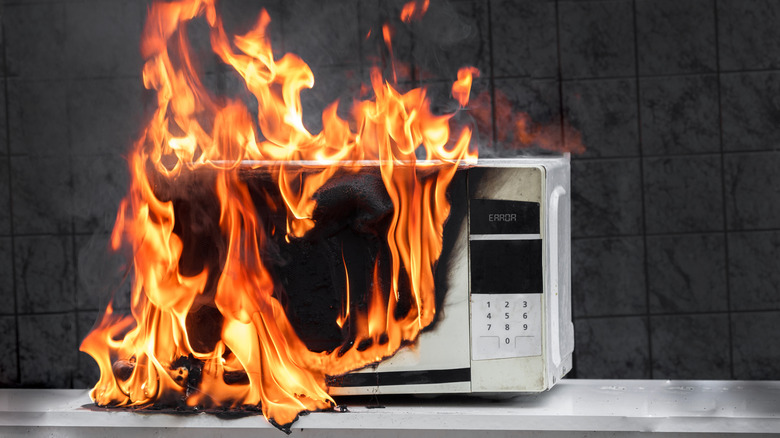The Ultra-Spicy Ingredient That Could Be Dangerous To Microwave
The microwave is one of the 20th century's greatest inventions. Since its invention in 1945, it has saved home cooks immeasurable time and effort, but while it may be incredibly convenient, it's not a panacea — there are still risks that come from using the appliance on items that are unsuited for it. While everyone knows not to microwave metal or Styrofoam, one ingredient that you might not realize should never go in the microwave is fresh, spicy chili peppers.
There are plenty of things that you are putting in the microwave but shouldn't, but the dangers posed vary by item. Some are less obvious to the naked eye; for example, processed meat can form hazardous compounds called N-nitroso compounds when exposed to high heat, and microwave-safe plastic is actually a myth due to the release of toxic phthalates. Other items display their perilousness in more obvious ways, like the explosive reason you should never microwave hard-boiled eggs. Chili peppers won't explode the way boiled eggs do, but the hazard they pose is no less immediately felt.
Simply put, microwaving spicy peppers is the quickest way to learn what it feels like to be pepper-sprayed. There's a risk of the peppers catching fire but the bigger danger is that the heat of the appliance causes the capsaicin, the compound responsible for the spiciness of a pepper, to release into the air. There, they bounce around until you open the microwave, at which point you're at risk of inhaling pure aerseol capsaicin, which can be incredibly harmful on your throat and eyes.
Safe alternatives to microwaving spicy peppers
If the reason you want to microwave your peppers is to soften them before cooking, your best bet is to roast them above an open flame or in a broiler, allowing them to develop a nice, black char on the outside. From there, you can serve it as is (it makes a delightful topping to a bacon-wrapped hot dog) or cover it with tin foil for several minutes to steam it. From there, the skin can be removed, and it can easily be deseeded and used in salsas or a steamed take on a chile relleno, an underrated Mexican restaurant staple.
If, on the other hand, your intention is to tame the heat of your peppers, there are some tricks to know beyond simple de-seeding. In fact, contrary to popular belief, the seeds are not actually the spiciest part of the pepper. Instead, it's the pith — the white, stringy tissue that makes up the ribs and holds the seeds — that really does the most damage. Removing them will help, but to really take the beast, you need to get scientific.
It turns out that acid is the best combatant to spice, so submerging your peppers in an acidic liquid can go a long way. Citrusy soda like Sprite can quickly neutralize the heat while a combination of white vinegar and soda water can have a similar effect but will likely take a little longer. Both of these are safer and less likely to result in a trip to the emergency room than microwaving the chili.


